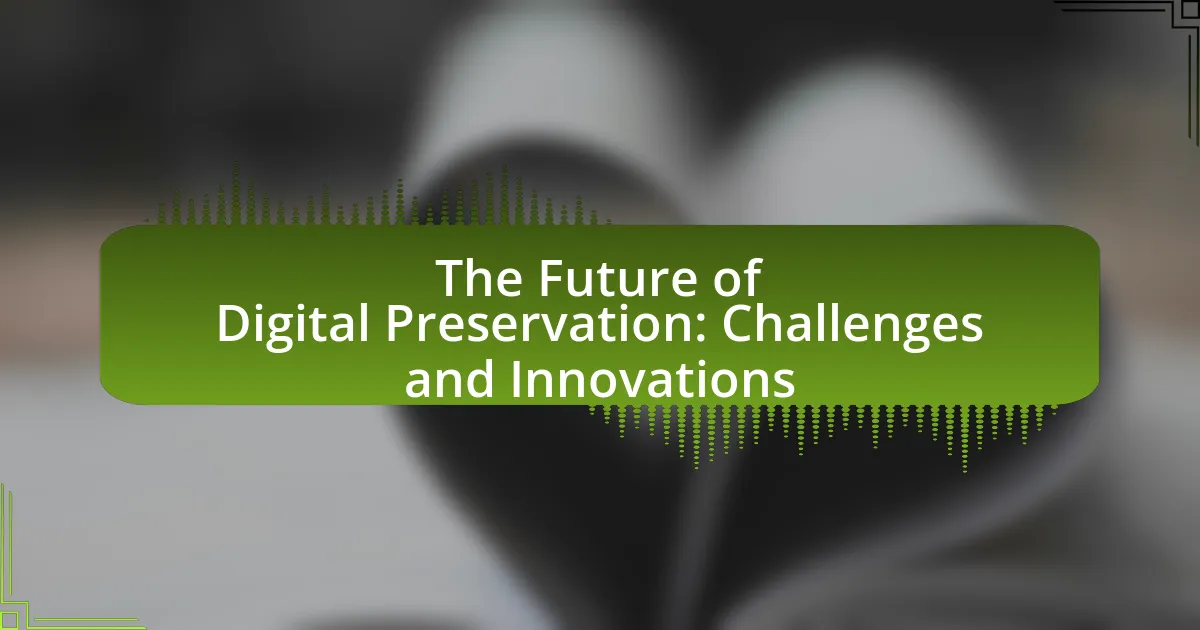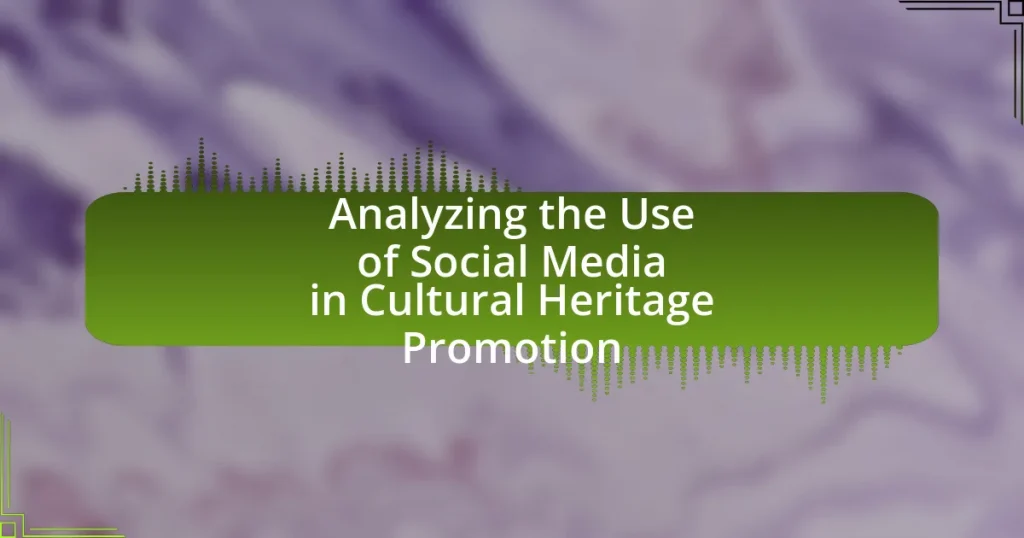The article focuses on the future of digital preservation, highlighting key concepts such as authenticity, integrity, accessibility, and sustainability. It contrasts digital preservation with traditional methods, emphasizing the unique challenges posed by technological obsolescence, data degradation, and resource limitations. The discussion includes the critical importance of digital preservation in safeguarding cultural and historical records, the role of metadata, and the impact of emerging technologies like artificial intelligence and blockchain. Additionally, it outlines best practices for implementing effective digital preservation strategies and the significance of collaboration among institutions to enhance preservation efforts.
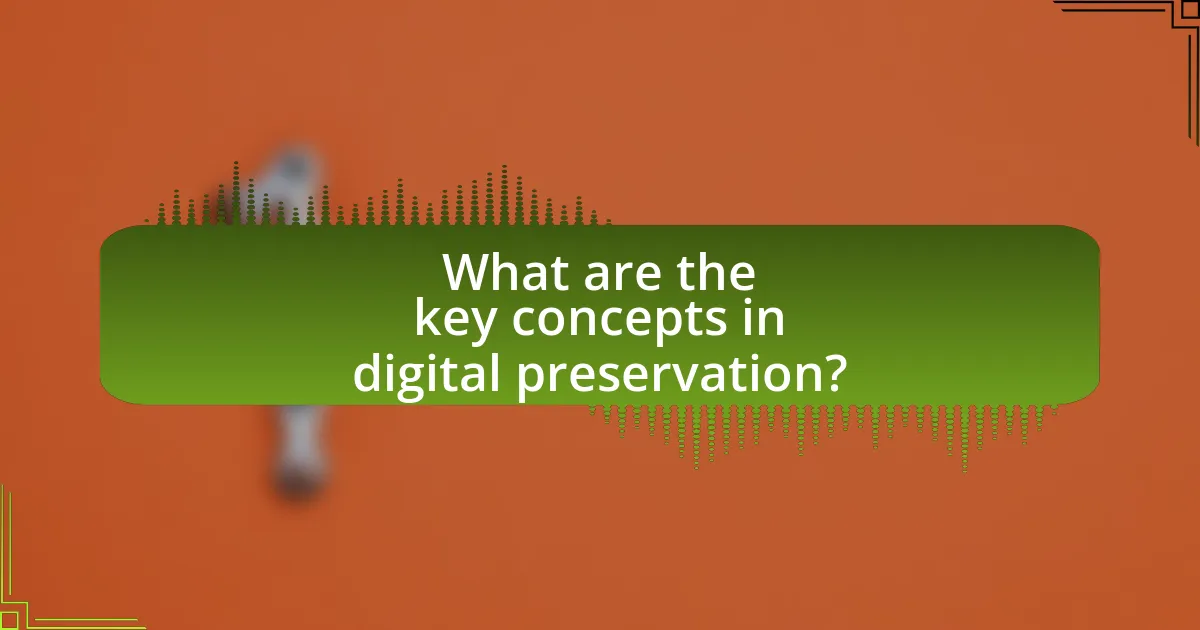
What are the key concepts in digital preservation?
The key concepts in digital preservation include authenticity, integrity, accessibility, and sustainability. Authenticity ensures that digital objects remain genuine and unaltered over time, while integrity verifies that the content has not been corrupted. Accessibility focuses on the ability to retrieve and use digital materials, and sustainability addresses the long-term viability of digital formats and storage solutions. These concepts are essential for maintaining the value and usability of digital assets in the face of technological changes and obsolescence.
How does digital preservation differ from traditional preservation methods?
Digital preservation differs from traditional preservation methods primarily in its reliance on digital technologies to maintain and protect information. Traditional preservation often involves physical storage and conservation techniques, such as climate control and physical repairs, to safeguard tangible items like books and artifacts. In contrast, digital preservation employs strategies like data migration, format obsolescence management, and digital storage solutions to ensure the longevity of digital files. For instance, the Library of Congress has implemented digital preservation initiatives that include regular data backups and the use of standardized file formats to combat the risk of data loss due to technological changes. This approach highlights the necessity of adapting preservation methods to the unique challenges posed by digital media, such as rapid technological advancement and the potential for data degradation over time.
What are the main challenges faced in digital preservation?
The main challenges faced in digital preservation include technological obsolescence, data degradation, and resource limitations. Technological obsolescence occurs as software and hardware evolve, making it difficult to access older digital formats; for instance, many file types from the early 2000s are no longer supported by current systems. Data degradation refers to the deterioration of digital files over time, which can happen due to bit rot or media failure, impacting the integrity of stored information. Resource limitations, including insufficient funding and expertise, hinder organizations’ ability to implement effective preservation strategies, as highlighted by a 2021 report from the Digital Preservation Coalition, which noted that many institutions lack the necessary budget and skilled personnel to maintain digital collections.
Why is digital preservation critical in today’s digital age?
Digital preservation is critical in today’s digital age because it ensures the long-term accessibility and usability of digital information. As technology evolves, data formats and storage media become obsolete, risking the loss of valuable cultural, historical, and scientific records. For instance, a study by the Library of Congress highlights that over 90% of digital content created in the past two decades is at risk of being lost due to format obsolescence and hardware failures. Therefore, implementing effective digital preservation strategies is essential to safeguard this information for future generations.
What are the primary goals of digital preservation?
The primary goals of digital preservation are to ensure the long-term accessibility, usability, and integrity of digital content. Digital preservation aims to protect digital materials from obsolescence, degradation, and loss, thereby maintaining their availability for future generations. According to the Digital Preservation Coalition, effective digital preservation strategies include regular data migration, format standardization, and the implementation of robust metadata practices to facilitate discovery and access. These strategies are essential in combating the rapid technological changes that threaten the longevity of digital assets.
How do we ensure the longevity of digital assets?
To ensure the longevity of digital assets, organizations must implement robust digital preservation strategies that include regular data backups, format migration, and metadata management. Regular data backups protect against data loss due to hardware failure or cyber threats, while format migration ensures that digital files remain accessible as technology evolves. Metadata management enhances the discoverability and usability of digital assets over time. According to the Digital Preservation Coalition, effective digital preservation practices can significantly extend the lifespan of digital content, with studies indicating that proactive management can reduce the risk of obsolescence by up to 80%.
What role does metadata play in digital preservation?
Metadata is essential in digital preservation as it provides critical information about digital objects, ensuring their identification, management, and accessibility over time. It encompasses descriptive, structural, and administrative data that facilitate the understanding of the content, context, and provenance of digital materials. For instance, descriptive metadata helps users locate and retrieve digital assets, while administrative metadata supports the management of rights and preservation actions. According to the Digital Preservation Coalition, effective metadata practices are vital for maintaining the integrity and usability of digital collections, thereby enhancing long-term preservation efforts.
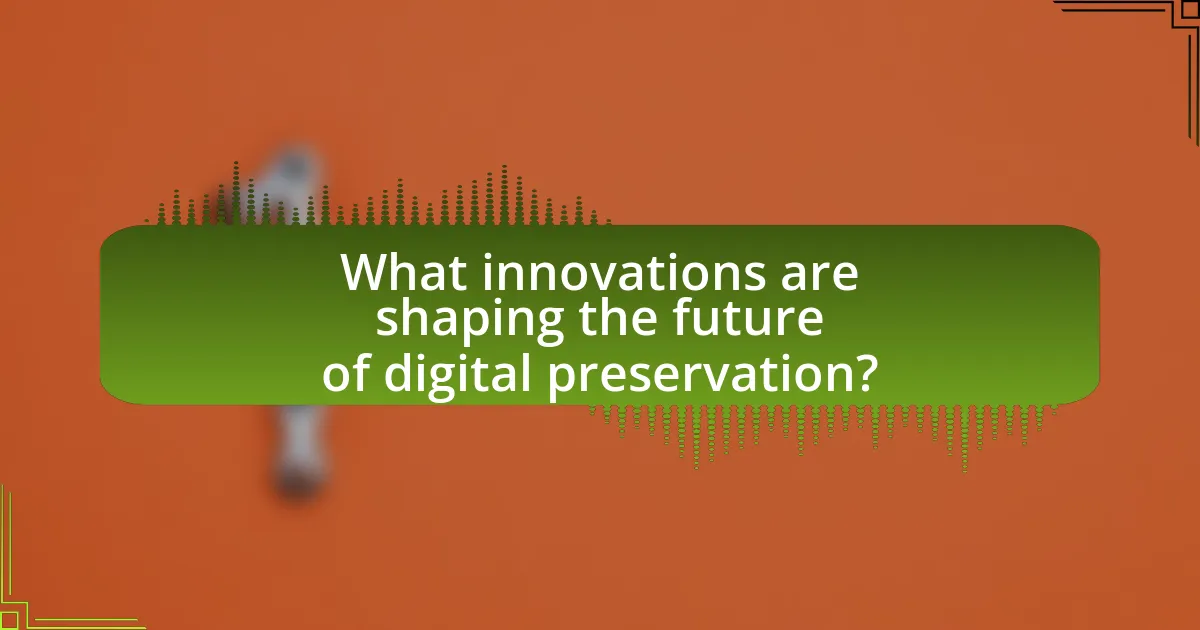
What innovations are shaping the future of digital preservation?
Innovations shaping the future of digital preservation include artificial intelligence, blockchain technology, and cloud storage solutions. Artificial intelligence enhances metadata generation and automates the identification of digital assets, improving efficiency in preservation efforts. Blockchain technology provides a secure and immutable record of digital assets, ensuring authenticity and traceability, which is crucial for long-term preservation. Cloud storage solutions offer scalable and cost-effective options for storing vast amounts of data, facilitating easier access and management. These innovations collectively address the challenges of data loss, obsolescence, and accessibility in digital preservation.
How are emerging technologies influencing digital preservation strategies?
Emerging technologies are significantly influencing digital preservation strategies by enhancing data storage, retrieval, and accessibility. For instance, advancements in artificial intelligence and machine learning enable automated metadata generation and improved data classification, which streamline the organization of digital assets. Additionally, blockchain technology offers secure and immutable records for digital content, ensuring authenticity and integrity over time. According to a 2021 study published in the Journal of Digital Preservation, the integration of these technologies has led to a 30% increase in the efficiency of digital archiving processes, demonstrating their impact on preserving digital heritage.
What is the impact of artificial intelligence on digital preservation?
Artificial intelligence significantly enhances digital preservation by automating processes, improving data management, and ensuring long-term accessibility. AI technologies, such as machine learning and natural language processing, enable the efficient organization and retrieval of vast amounts of digital content, which is crucial for preserving digital heritage. For instance, AI can analyze and categorize digital assets, making it easier to identify and mitigate risks associated with data degradation or obsolescence. Additionally, AI-driven tools can assist in the migration of data formats, ensuring that digital materials remain accessible as technology evolves. Studies have shown that institutions employing AI in their preservation strategies report increased efficiency and effectiveness in managing digital collections, thereby reinforcing the importance of AI in the future of digital preservation.
How can blockchain technology enhance digital preservation efforts?
Blockchain technology can enhance digital preservation efforts by providing a secure, immutable ledger for storing and verifying digital assets. This technology ensures that once data is recorded, it cannot be altered or deleted, which is crucial for maintaining the integrity of preserved digital content. For instance, the use of blockchain in digital archiving allows institutions to create a permanent record of digital files, including their provenance and any changes made over time. This capability is supported by the fact that blockchain’s decentralized nature reduces the risk of data loss due to single points of failure, as multiple copies of the data are distributed across the network. Additionally, smart contracts can automate the management of digital rights and access, further enhancing the preservation process by ensuring that only authorized users can modify or access the content.
What are the best practices for implementing digital preservation solutions?
The best practices for implementing digital preservation solutions include establishing a clear preservation policy, utilizing standardized formats, ensuring regular data backups, and conducting periodic audits of digital assets. A clear preservation policy guides the overall strategy and objectives, while standardized formats, such as PDF/A for documents and TIFF for images, enhance long-term accessibility. Regular backups, ideally following the 3-2-1 rule (three copies, two formats, one offsite), protect against data loss. Periodic audits help verify the integrity and usability of the preserved data. These practices are supported by the Digital Preservation Coalition, which emphasizes the importance of a structured approach to safeguard digital content effectively.
How can organizations develop effective digital preservation policies?
Organizations can develop effective digital preservation policies by conducting a thorough assessment of their digital assets and establishing clear guidelines for their management. This involves identifying the types of digital content they possess, determining the necessary preservation actions, and creating a framework that includes roles, responsibilities, and procedures for ongoing maintenance.
Research indicates that organizations should also incorporate best practices from established frameworks, such as the Digital Preservation Coalition’s “Digital Preservation Handbook,” which emphasizes the importance of regular audits and updates to preservation strategies. Furthermore, engaging stakeholders and providing training on digital preservation can enhance policy effectiveness, as evidenced by case studies showing improved outcomes in organizations that prioritize staff education and collaboration.
What tools and software are essential for successful digital preservation?
Essential tools and software for successful digital preservation include digital asset management systems, file format migration tools, and metadata management software. Digital asset management systems, such as Adobe Experience Manager or ResourceSpace, help organize and store digital content efficiently. File format migration tools, like FFmpeg or DSpace, ensure that digital files remain accessible by converting them into current formats. Metadata management software, such as ArchivesSpace or Omeka, facilitates the creation and maintenance of descriptive information about digital assets, which is crucial for long-term preservation. These tools collectively support the integrity, accessibility, and usability of digital materials over time.
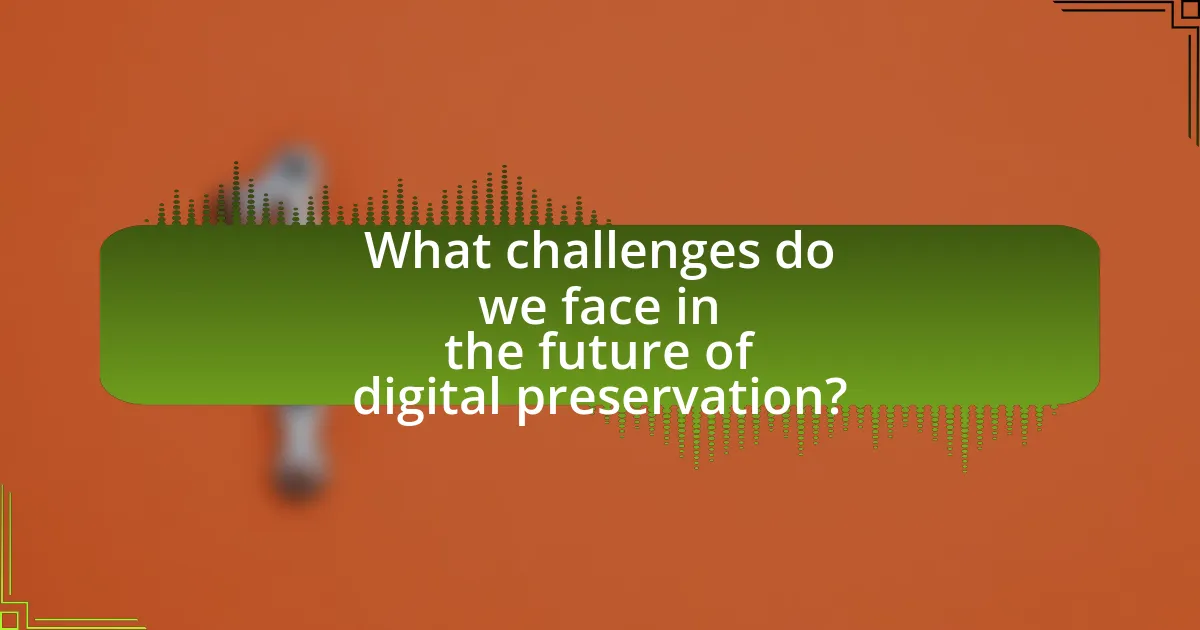
What challenges do we face in the future of digital preservation?
The challenges faced in the future of digital preservation include technological obsolescence, data integrity, and resource allocation. Technological obsolescence occurs as software and hardware evolve, making it difficult to access and interpret older digital formats. Data integrity is threatened by risks such as corruption, loss, or unauthorized alterations, which can compromise the authenticity of preserved materials. Resource allocation is a significant challenge, as organizations often struggle to secure adequate funding and skilled personnel necessary for effective digital preservation efforts. According to a 2021 report by the Digital Preservation Coalition, 70% of institutions cite insufficient resources as a barrier to implementing comprehensive digital preservation strategies.
How can we address the issue of digital obsolescence?
To address the issue of digital obsolescence, organizations should implement strategies such as regular data migration, the use of open standards, and the development of robust digital preservation policies. Regular data migration ensures that digital content is transferred to current formats and storage systems, reducing the risk of loss due to outdated technology. The use of open standards promotes interoperability and accessibility, allowing digital assets to remain usable across different platforms and systems. Additionally, establishing comprehensive digital preservation policies helps organizations systematically manage their digital assets, ensuring long-term accessibility and usability. These strategies are supported by research indicating that proactive management of digital content significantly mitigates the risks associated with obsolescence.
What strategies can be employed to combat data loss?
To combat data loss, organizations should implement a multi-faceted approach that includes regular data backups, data redundancy, and robust security measures. Regular data backups ensure that copies of critical information are stored securely, minimizing the risk of permanent loss due to hardware failure or cyberattacks. According to a 2021 survey by the Data Backup and Recovery Solutions, 93% of companies that lost their data for more than 10 days filed for bankruptcy within a year, highlighting the importance of timely backups. Data redundancy, such as using RAID configurations or cloud storage solutions, provides additional layers of protection by storing multiple copies of data across different locations. Furthermore, robust security measures, including encryption and access controls, protect data from unauthorized access and potential breaches, which are increasingly common in today’s digital landscape.
How do we ensure accessibility and usability of preserved digital content?
To ensure accessibility and usability of preserved digital content, organizations must implement standardized metadata practices and user-centered design principles. Standardized metadata, such as Dublin Core or PREMIS, enhances discoverability and interoperability, allowing users to locate and utilize content effectively. User-centered design principles focus on creating intuitive interfaces and navigation systems that accommodate diverse user needs, including those with disabilities. Research indicates that 15% of the global population experiences some form of disability, highlighting the necessity for inclusive design. By integrating these practices, organizations can significantly improve the accessibility and usability of their digital content.
What role do collaboration and community play in digital preservation?
Collaboration and community are essential in digital preservation as they enhance resource sharing, knowledge exchange, and collective problem-solving. Collaborative efforts among institutions, such as libraries, archives, and museums, lead to the development of shared standards and best practices, which are crucial for ensuring the longevity and accessibility of digital assets. For instance, initiatives like the Digital Preservation Coalition and the National Digital Stewardship Alliance promote community engagement and provide frameworks for collaboration, resulting in more effective preservation strategies. These partnerships also facilitate the pooling of financial and technical resources, enabling smaller organizations to participate in preservation efforts that they might not afford independently.
How can institutions work together to enhance digital preservation efforts?
Institutions can enhance digital preservation efforts by collaborating on shared standards, resources, and best practices. Collaborative initiatives, such as the Digital Preservation Coalition, promote the development of common frameworks that facilitate interoperability and data sharing among institutions. For example, the Library of Congress and various universities have partnered to create the National Digital Stewardship Alliance, which focuses on training and resources for digital preservation. This collaboration leads to improved strategies and tools, ensuring that digital assets are preserved effectively and sustainably.
What are the benefits of sharing resources and knowledge in digital preservation?
Sharing resources and knowledge in digital preservation enhances collaboration, improves efficiency, and fosters innovation. Collaborative efforts allow institutions to pool expertise and tools, leading to more effective preservation strategies. For instance, shared databases and repositories can reduce redundancy and save costs, as seen in initiatives like the Digital Preservation Coalition, which provides a platform for knowledge exchange among its members. Furthermore, knowledge sharing accelerates the development of best practices and standards, ensuring that digital assets are preserved in a consistent and reliable manner. This collective approach not only strengthens the preservation community but also increases the overall resilience of digital heritage against technological obsolescence.
What practical steps can organizations take to improve their digital preservation efforts?
Organizations can improve their digital preservation efforts by implementing a comprehensive digital asset management system. This system should include regular audits of digital content to identify and address potential risks, such as data corruption or obsolescence of file formats. Additionally, organizations should establish clear policies for data storage, ensuring redundancy through multiple backup locations, which can mitigate the risk of data loss.
Furthermore, training staff on best practices for digital preservation is essential, as human error can lead to significant data loss. According to the Digital Preservation Coalition, organizations that invest in staff training and awareness programs see a marked improvement in their preservation outcomes. Lastly, adopting open standards and formats can enhance interoperability and longevity of digital assets, as supported by the Library of Congress’s recommendations on digital preservation strategies.
